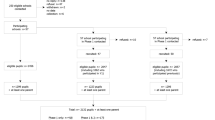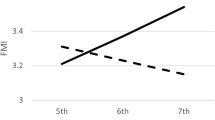Abstract
Objective:
To determine if time spent in objectively measured sedentary behavior is associated with a change in body mass index (BMI) between ages 9 and 15 years, adjusting for moderate-to-vigorous physical activity (MVPA).
Design:
Prospective observational study of children at ages 9 (2000), 11 (2002), 12 (2003) and 15 years (2006). Longitudinal quantile regression was used to model the influence of predictors on changes at the 10th, 25th, 50th, 75th and 90th BMI percentiles over time.
Subjects:
Participants were enrolled in the National Institute of Child Health and Human Development (NICHD) Study of Early Child Care and Youth Development and include both boys and girls (n=789).
Measurements:
Objectively measured BMI (kg m–2) was the outcome variable and objectively measured sedentary behavior was the main predictor. Adjustment was also made for MVPA, gender, race, maternal education, hours of sleep and healthy eating index.
Results:
Increases in BMI were observed at all percentiles, with the greatest increase observed at the 90th BMI percentile. Spending more time in sedentary behavior (h per day) was associated with additional increases in BMI at the 90th, 75th and 50th BMI percentiles, independent of MVPA and the other covariates (90th percentile=0.59, 95% confidence interval (95% CI): 0.19–0.98 kg m–2; 75th percentile=0.48, 95% CI: 0.25–0.72 kg m–2; and 50th percentile=0.19, 95% CI: 0.05–0.33 kg m–2). No associations were observed between sedentary behavior and changes at the 25th and 10th BMI percentiles.
Conclusion:
Sedentary behavior was associated with greater increases in BMI at the 90th, 75th and 50th BMI percentiles between ages 9 and 15 years, independent of MVPA. Preventing an increase in sedentary behavior from childhood to adolescence may contribute to reducing the number of children classified as obese.
This is a preview of subscription content, access via your institution
Access options
Subscribe to this journal
Receive 12 print issues and online access
$259.00 per year
only $21.58 per issue
Buy this article
- Purchase on Springer Link
- Instant access to full article PDF
Prices may be subject to local taxes which are calculated during checkout


Similar content being viewed by others
References
Flegal KM, Carroll MD, Ogden CL, Curtin LR . Prevalence and trends in obesity among US adults, 1999-2008. JAMA 2010; 303: 235–241.
Flegal KM, Carroll MD, Ogden CL, Johnson CL . Prevalence and trends in obesity among US adults, 1999-2000. JAMA 2002; 288: 1723–1727.
Ogden CL, Carroll MD, Curtin LR, Lamb MM, Flegal KM . Prevalence of high body mass index in US children and adolescents, 2007-2008. JAMA 2010; 303: 242–249.
Baker JL, Olsen LW, Sorensen TI . Childhood body-mass index and the risk of coronary heart disease in adulthood. N Engl J Med 2007; 357: 2329–2337.
Tirosh A, Shai I, Afek A, Dubnov-Raz G, Ayalon N, Gordon B et al. Adolescent BMI trajectory and risk of diabetes versus coronary disease. N Engl J Med 2011; 364: 1315–1325.
McAllister EJ, Dhurandhar NV, Keith SW, Aronne LJ, Barger J, Baskin M et al. Ten putative contributors to the obesity epidemic. Crit Rev Food Sci Nutr 2009; 49: 868–913.
Komlos J, Breitfelder A, Sunder M . The transition to post-industrial BMI values among US children. Am J Hum Biol 2009; 21: 151–160.
Matthews CE, Chen KY, Freedson PS, Buchowski MS, Beech BM, Pate RR et al. Amount of time spent in sedentary behaviors in the United States, 2003–2004. Am J Epidemiol 2008; 167: 875–881.
Danner FW . A national longitudinal study of the association between hours of TV viewing and the trajectory of BMI growth among US children. J Pediatr Psychol 2008; 33: 1100–1107.
Delmas C, Platat C, Schweitzer B, Wagner A, Oujaa M, Simon C . Association between television in bedroom and adiposity throughout adolescence. Obesity (Silver Spring) 2007; 15: 2495–2503.
Elgar FJ, Roberts C, Moore L, Tudor-Smith C . Sedentary behaviour, physical activity and weight problems in adolescents in Wales. Public Health 2005; 119: 518–524.
Epstein LH, Roemmich JN, Robinson JL, Paluch RA, Winiewicz DD, Fuerch JH et al. A randomized trial of the effects of reducing television viewing and computer use on body mass index in young children. Arch Pediatr Adolesc Med 2008; 162: 239–245.
Must A, Bandini LG, Tybor DJ, Phillips SM, Naumova EN, Dietz WH . Activity, inactivity, and screen time in relation to weight and fatness over adolescence in girls. Obesity (Silver Spring) 2007; 15: 1774–1781.
Proctor MH, Moore LL, Gao D, Cupples LA, Bradlee ML, Hood MY et al. Television viewing and change in body fat from preschool to early adolescence: the Framingham Children's Study. Int J Obes Relat Metab Disord 2003; 27: 827–833.
Robinson TN . Reducing children's television viewing to prevent obesity: a randomized controlled trial. JAMA 1999; 282: 1561–1567.
Davison KK, Marshall SJ, Birch LL . Cross-sectional and longitudinal associations between TV viewing and girls’ body mass index, overweight status, and percentage of body fat. J Pediatr 2006; 149: 32–37.
Treuth MS, Baggett CD, Pratt CA, Going SB, Elder JP, Charneco EY et al. A longitudinal study of sedentary behavior and overweight in adolescent girls. Obesity (Silver Spring) 2009; 17: 1003–1008.
NICHD Early Child Care Research Network. Nonmaternal care and family factors in early development: an overview of the NICHD Study of Early Child Care. Appl Dev Psychol 2001; 22: 457–492.
Nader PR, Bradley RH, Houts RM, McRitchie SL, O’Brien M . Moderate-to-vigorous physical activity from ages 9 to 15 years. JAMA 2008; 300: 295–305.
Troiano RP, Berrigan D, Dodd KW, Masse LC, Tilert T, Mcdowell M . Physical activity in the United States measured by accelerometer. Med Sci Sports Exerc 2008; 40: 181–188.
Healy GN, Dunstan DW, Salmon J, Cerin E, Shaw JE, Zimmet PZ et al. Breaks in sedentary time: beneficial associations with metabolic risk. Diabetes Care 2008; 31: 661–666.
Steele RM, van Sluijs EM, Cassidy A, Griffin SJ, Ekelund U . Targeting sedentary time or moderate- and vigorous-intensity activity: independent relations with adiposity in a population-based sample of 10-y-old British children. Am J Clin Nutr 2009; 90: 1185–1192.
Evenson KR, Catellier DJ, Gill K, Ondrak KS, McMurray RG . Calibration of two objective measures of physical activity for children. J Sports Sci 2008; 26: 1557–1565.
Trost SG, Loprinzi PD, Moore R, Pfeiffer KA . Comparison of accelerometer cut-points for predicting activity intensity in youth. Med Sci Sports Exerc 2010; 43: 1360–1368.
Cole TJ, Bellizzi MC, Flegal KM, Dietz WH . Establishing a standard definition for child overweight and obesity worldwide: international survey. BMJ 2000; 320: 1240–1243.
Brodersen NH, Steptoe A, Boniface DR, Wardle J . Trends in physical activity and sedentary behaviour in adolescence: ethnic and socioeconomic differences. Br J Sports Med 2007; 41: 140–144.
Wardle J, Brodersen NH, Cole TJ, Jarvis MJ, Boniface DR . Development of adiposity in adolescence: five year longitudinal study of an ethnically and socioeconomically diverse sample of young people in Britain. BMJ 2006; 332: 1130–1135.
Johnson JG, Cohen P, Kasen S, First MB, Brook JS . Association between television viewing and sleep problems during adolescence and early adulthood. Arch Pediatr Adolesc Med 2004; 158: 562–568.
Carter PJ, Taylor BJ, Williams SM, Taylor RW . Longitudinal analysis of sleep in relation to BMI and body fat in children: the FLAME study. BMJ 2011; 342: d2712.
Vader AM, Walters ST, Harris TR, Hoelscher DM . Television viewing and snacking behaviors of fourth- and eighth-grade schoolchildren in Texas. Prev Chronic Dis 2009; 6: A89.
Wei Y, Pere A, Koenker R, He X . Quantile regression methods for reference growth charts. Stat Med 2006; 25: 1369–1382.
Hao L, Naimen DQ . Quantile Regression. SAGE Publications: Thousand Oaks, 2007.
Beyerlein A, Toschke AM, von Kries R . Risk factors for childhood overweight: shift of the mean body mass index and shift of the upper percentiles: results from a cross-sectional study. Int J Obes 2010; 34: 642–648.
Beyerlein A, Toschke AM, Rosario AS, von Kries R . Risk factors for obesity: further evidence for stronger effects on overweight children and adolescents compared to normal-weight subjects. PLoS One 2011; 6: e15739.
Levine JA, Lanningham-Foster LM, McCrady SK, Krizan AC, Olson LR, Kane PH et al. Interindividual variation in posture allocation: possible role in human obesity. Science 2005; 307: 584–586.
Pabayo R, Gauvin L, Barnett TA, Nikiema B, Seguin L . Sustained active transportation is associated with a favorable body mass index trajectory across the early school years: findings from the Quebec Longitudinal Study of Child Development birth cohort. Prev Med 2010; 50 (Suppl 1): S59–S64.
Benden M, Blake J, Wendel M, Huber J . The impact of stand-biased desks in classrooms on calorie expenditure in children. Am J Public Health 2011; 101: 1433–1436.
Saelens BE, Seeley RJ, van Schaick K, Donnelly LF, O’Brien KJ . Visceral abdominal fat is correlated with whole-body fat and physical activity among 8-y-old children at risk of obesity. Am J Clin Nutr 2007; 85: 46–53.
Kozey SL, Staudenmayer JW, Troiano RP, Freedson PS . Comparison of the ActiGraph 7164 and the ActiGraph GT1M during self-paced locomotion. Med Sci Sports Exerc 2010; 42: 971–976.
Acknowledgements
This study was conducted by the NICHD Early Child Care Research Network supported by NICHD through a cooperative agreement that calls for scientific collaboration between the grantees and the NICHD staff. We thank Dr Matteo Bottai for helping with the quantile regression analyses.
Author information
Authors and Affiliations
Corresponding author
Ethics declarations
Competing interests
The authors declare no conflict of interest.
Rights and permissions
About this article
Cite this article
Mitchell, J., Pate, R., Beets, M. et al. Time spent in sedentary behavior and changes in childhood BMI: a longitudinal study from ages 9 to 15 years. Int J Obes 37, 54–60 (2013). https://doi.org/10.1038/ijo.2012.41
Received:
Revised:
Accepted:
Published:
Issue Date:
DOI: https://doi.org/10.1038/ijo.2012.41
Keywords
This article is cited by
-
A natural experiment to assess recess frequency on children’s physical activity in Arizona (U.S.) elementary schools
BMC Public Health (2024)
-
Adolescent sedentary behavior and body composition in early adulthood: results from a cohort study
Pediatric Research (2023)
-
Changes in physical activity patterns of students from primary to secondary school: a 5-year longitudinal study
Scientific Reports (2022)
-
Trajectories of objectively measured physical activity and childhood overweight: longitudinal analysis of the IDEFICS/I.Family cohort
International Journal of Behavioral Nutrition and Physical Activity (2021)
-
Identification of the minimum data set to design a mobile-based application on overweight and obesity management for children and adolescents
Journal of Diabetes & Metabolic Disorders (2021)



